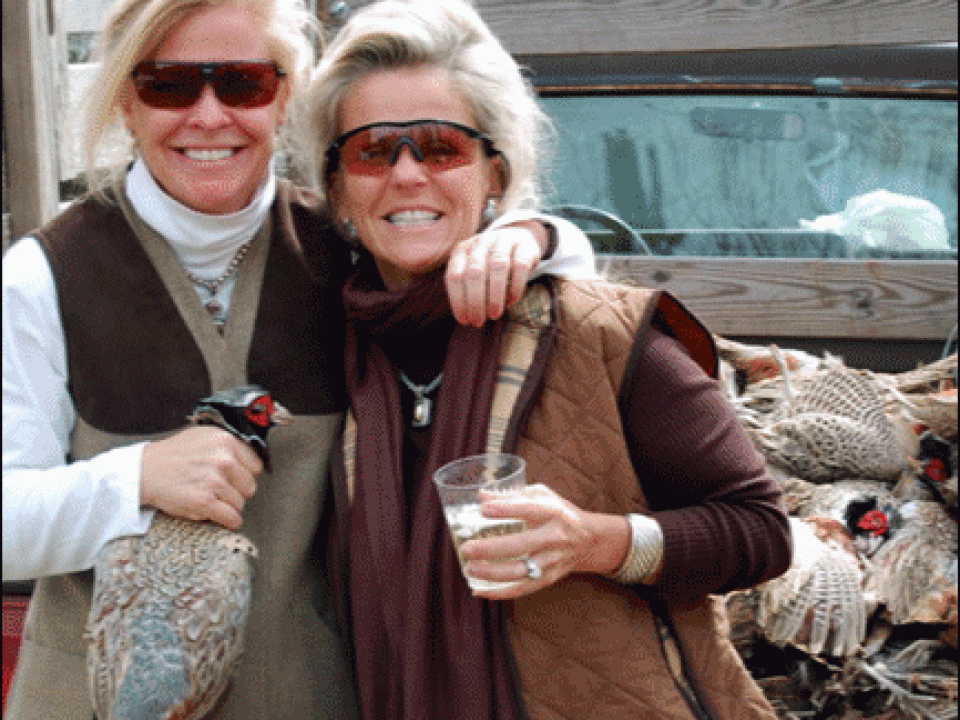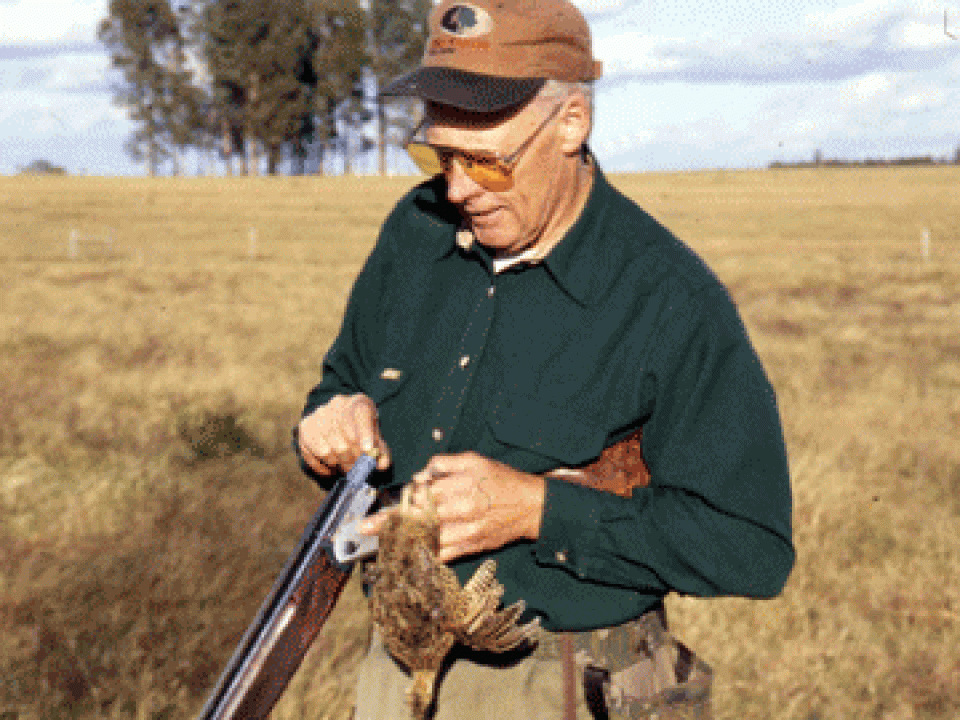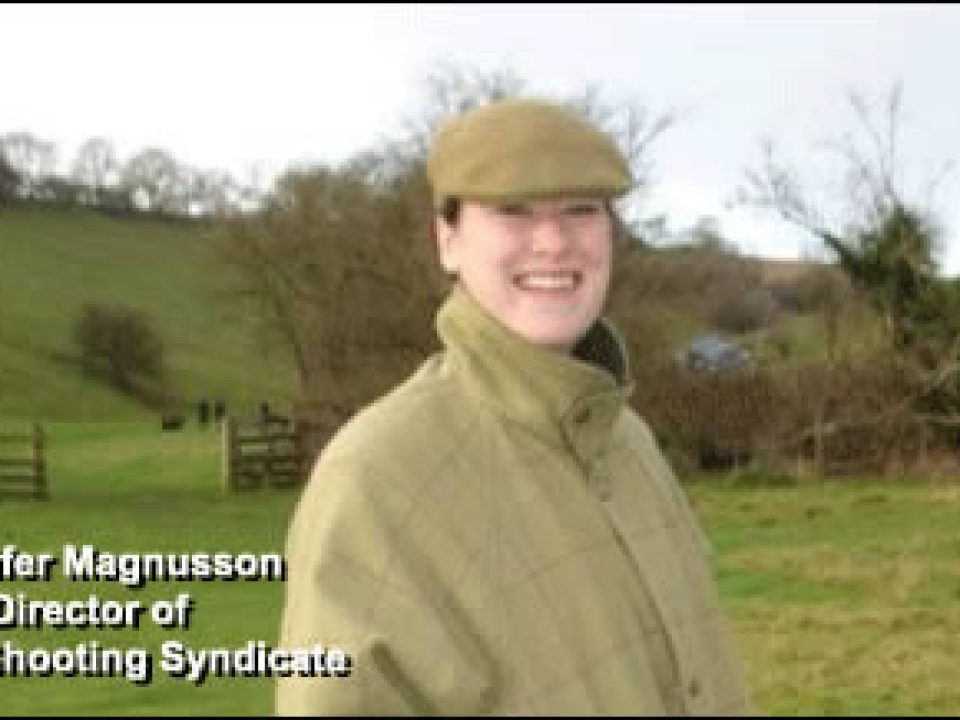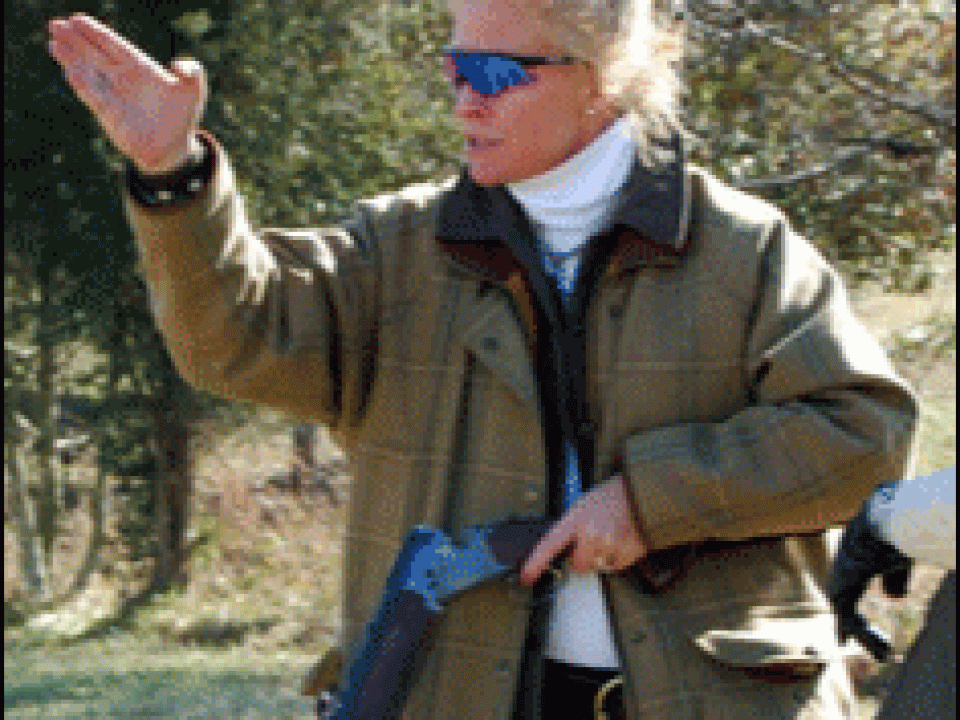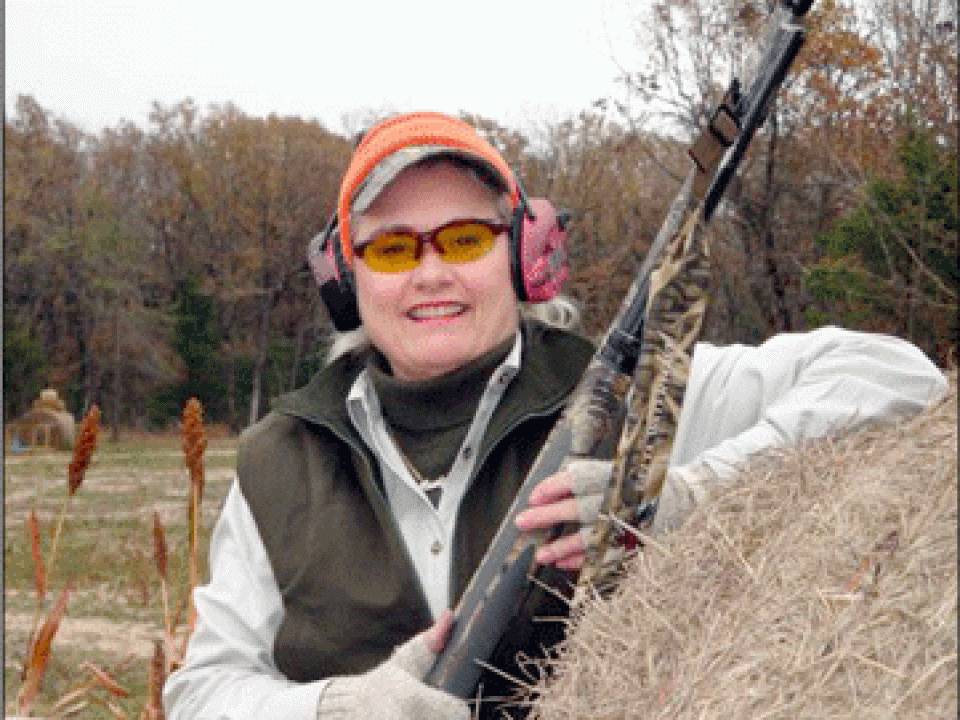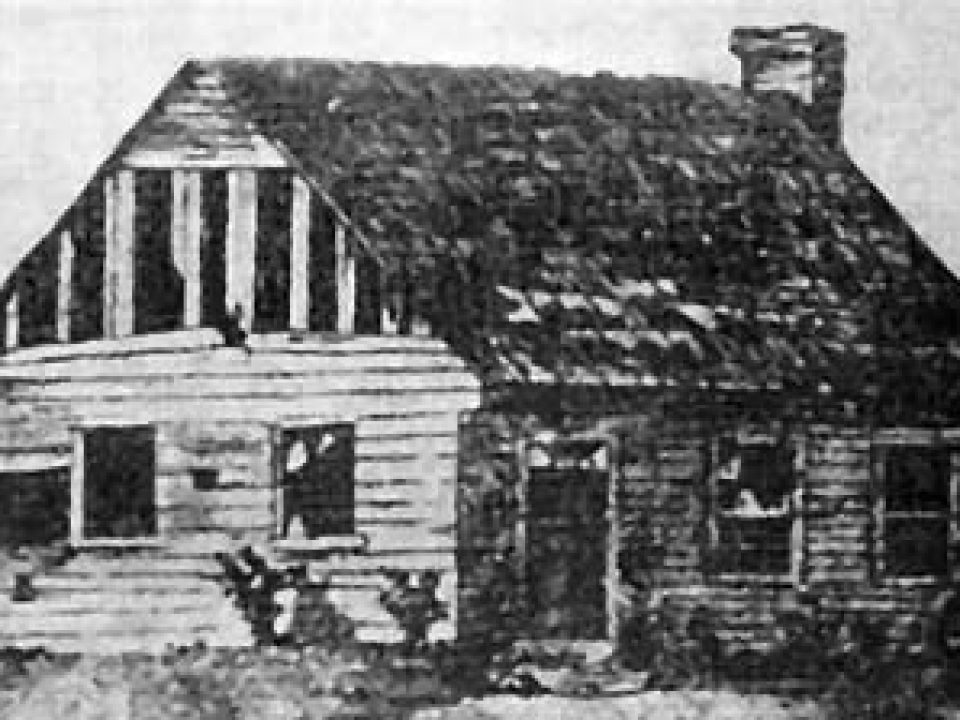I will never forget the first time I saw one of my best friends take a shooting lesson…
shooting
The Triple Crown of Sporting Clays Resorts
Part 1: The Greenbrier
You know a road trip is going be great when, on the first leg of it, Johnny Cash comes on the radio and sings “Ghost Riders in the Sky.”
Your SUV is packed with sporting clays guns, ammo and shooting gear and Cash’s renegade ballad sends a shiver down your spine. You wonder, Does it really get any better than this?
For us, the answer would be a resounding yes.
Wingshooting In Uruguay With Eduardo Gonzales
Although my first shooting trip to South America took place in 1972 I didn’t get to shoot in Uruguay until 1997. In retrospect I hate that I missed shooting in that country and enjoying those wonderful people for so many decades. This had been a winter trip, so the duck and partridge seasons were in full swing. Of course, it was summer back here in the USA.
Jim and Bugsy: Against All Odds
In a riverfront honky-tonk deep in the South, the sliding doors open to the verandah, women sat on bar stools wistfully blowing cigarette smoke at the stars.
It was the kind of forlorn place where a man could bring his bird dog and let it curl up on the floor between the stools, and you could never tell which one stunk worse – the man or the dog.
Time was of no consequence in this place, here on the river, in the darkness, where the hours and minutes were marked by the bug zappers incinerating their random catch. Yes, the Universe was clearly at work, here, now, in this honky-tonk where men and women wandered in drawn by the Big Mystery.
I never did get the name of that bar, but there’s one thing I’ll always remember about that place. It was where I first met Jim and Bugsy.
Their table was heaped with the remnants of peel-and-eat shrimp and empty beer bottles. I’d accidentally bumped into a corner of the table on the way to the john, a bit sodden myself, when I whirled around to see Bugsy splendid in his Vintager apparel and Jim in a shooting vest and baseball cap.
They looked up at me – more startled than menacing. Both sported long, thick cigars, and I remembered what Freud once said.
Taking in the scene I thought “these men are my kind of men.” So I decided to hold it in and rather than hit the john, and asked, “Can you buy you gents a beer for the inconvenience?”
Bugsy broke out laughing and turned to Jim: “Can you believe this guy?”
Jim simply nodded, world weary and wise.
“Of course you can buy us a beer,” Bugsy shouted.
“Hefeweizen with a wedge of lemon?”
“Sure, why the hell not?” Bugsy shouted.
Jim simply waved his hand, as though to say, que sera, sera.
“Miss, oh, miss,” I called to the barmaid. “Three Hefeweizen with a wedge of fresh lemon, if you please.”
She was young and lithe with a tank tap and no bra and she leaned over into the ice box, drawing the attention of the great rough slab of tramp-steamer maleness, each of them shanghaied to this forsaken place, here on the river, and she put three long-necked Snake Venom Ales on the bar in front of me.
“We’re outta lemon wedges, handsome” she said. “Start a tab for you and your pals?”
“That would be excellent,” I said. “By the way, do you have any coasters?”
She turned away, and resumed her conversation with the burly men at the end of the bar.
“Hey, you gonna eyeball those beers all night or bring ’em over here?” Bugsy said.
“Sorry about the coasters,” I said sitting down. “Fielding-Clapp, Cletus.”
“Bugsy.”
“Jim.”
Bugsy had a mischievous glint in his eyes, his face part pugilist, part English professor. Jim wore a scruffy beard, his dark penetrating orbs awash in a secret sea of resignation whose powerful tides shifted with the whims of Lady Luck. I couldn’t help but notice he wore an orthopedic shoe with a platform sole; one leg was longer than the other.
Their cigar smoke enshrouded us in a place within a place, here on the lazy river. The bar opened directly on to the water, giving the impression that we were on a slow boat to the end of the world.
“Shrimp?” Bugsy asked, pushing the plastic basket toward me.
“That’s extremely generous,” I said, “but I have a shellfish allergy.”
“No worries,” Jim said. “I always carry antihistamines.”
I put forth a polite smile. “So I see you chaps are into shotguns.”
Bugsy broke out laughing. “Hey, this guy’s a regular Sherlock Holmes,” he said to Jim.”
“Don’t start,” Jim said.
“Actually, I write for Shotgun Life.”
“I love it,” Bugsy shouted. “Man, we’ve got something for you to write about.”
“Well, fire away.”
“That’s a challenge we’ll gladly accept,” Bugsy said. “Go ahead, Jim-bo, you go first.”
“I think I will.”
It turned out, that Jim was a dentist, originally from Long Island. He ended up down South to attend dental school in Charleston, South Carolina. And that’s when he started getting into shooting — at the end of dental school and his first residency.
He got invited on his first dove shoot, borrowing a neighbors bolt-action 16 gauge. It was old and weird. “I was hooked. I had a knack for it, and killed my limit rather quickly,” Jim recalled.
Well, by now Jim is married with three children and a successful dental practice.
Jim had also turned into a dove-hunting addict; and after doves he got hooked on quail. When he couldn’t hunt birds, he started to shoot skeet. If it flied, it died, whether it sported feathers or fluorescent orange, it was going down. And as he got deeper and deeper into the shotgun sports, he joined a shooting club in Charleston, which was where he met Bugsy.
After skeet, Jim and Bugsy discovered sporting clays. They started to shoot competitively. Every weekend, Jim was out shooting – and it didn’t matter what the heck it was…doves, quail, skeet, sporting clays…
Jim was telling all of this to me, until he paused for a moment of deep reflection., where he gazed into his fate like a warrior about to face the battle of his life… “Then I got bit by the tick,” he said.
Bugsy nodded to me, puffing on his cigar.
“It’s back in ’94,” Jim said. “I was on a dove hunt in Somerville, South Carolina. I got a tick bite without even noticing it – until the rash. Things started falling apart…neurological problems…my balance gave way and I started having pains and troubles with my legs.
“For almost two years, no one could diagnose it as Lyme’s disease. I went to urologists, neurologists and internists. People weren’t aware of Lyme’s disease at this point — and they never tested him for it. Mostly I was tested for MS, and it always came back negative.
“You see, Cletus, the doctors didn’t really believe that Lyme’s disease made its way all the way down south. You know, it was first detected in Lyme Connecticut.
“In the meantime my situation is deteriorating. Well, I finally got lucky. My sister and brother-in-law are physicians, and when they finally identified the problem, they put me on antibiotics immediately. And they also hooked me up with the head of infectious disease in Columbia, in South Carolina. My sister pulled strings.”
Jim pushed out his chair. He showed me his orthopedic shoe. “That’s what Lyme’s Disease will do to you. You tell your readers, first to spray before they go out to hunt, and if they’re bitten, they should run, not walk, to get treated.”
“Jim, you gotta face it, you’ve always been jinxed,” Bugsy said. “Falling on those fire ants…that woman who got sick on the plane next to you when we flew to Argentina…”
“Well, I do live under a cloud,” Jim told me. “But I’ve never been…” He gave Bugsy a meaningful glance that only men who’ve seen it can know how meaningful it really is.
Bugsy nodded. He took a long, enjoyable puff on his cigar. “Heck, Cletus, what I’ve been through, that’s just one more good story to tell.”
And he proceeded to tell it with a flourish…
His introduction to the shotgun sports was more sordid than Jim’s. At about 14, his parents introduced him to shooting in Savannah at the Forest City Gun Club in Savannah. They took him there because it was a private club and they could drink on Sundays.
As the years passed, he never lost of his love of shooting. He started a home-building company in Columbia, South Carolina called Colony Builders.
“That was 25 years ago when I started at Colony,” he said wistfully, puffing on his cigar.
Well, in the great tradition of the South, Bugsy introduced his son, Bugsy II, to hunting. In 1998, the father took his son for his first shooting trip outside of the U.S., to Mexico, in John Wayne territory: Rio Bravo.
To minimize any dangers, Bugsy decided to stay in Texas. From their base in McAllen, Bugsy and Bugsy II would cross the Pharr Bridge and make day hunts South of the Border. Bugsy knew his outfitter well and they always adhered to the same routine. Pick-up at around noon, shoot until 6:00 or 7:00 on the preserve, and then to the world-famous La Cucaracha in Reynosa for dinner.
It was the kind of routine that men followed through the ages – for time immemorial -until such said day, when out of the blue, it happened…
“The horror,” he said, gazing into the darkness, beyond the slow river.
“Well…,” Jim said.
Bugsy, never one to lose his composure while telling a good story, sucked it up and resumed his compelling narrative.
“We were hunting some five miles from Rio Bravo when a storm came up,” he recalled. “There had been a misty rain, the kind of rain that chills men to the bones and makes you want to brew up a strong cup of Earl Grey tea.
“So we get there, three vehicles full of hunters. It clears up and the rain quits. The day before it was all dry so you could drive to the spot but now it was all gumbo and you had to walk. We walk into the field – my son and myself and the two bird boys, and we’re out in the field, it begins to rain again. I don’t mind the rain but I don’t like the lightning. You know what I mean, Cletus?”
I nodded, a somber nod, reserved for men of few words, like Clint Eastwood in The Good, The Bad and The Ugly.
But off in the distance, lightning had hit an electrical transformer – causing a loud explosion. “By my count, 1, 2, 3, I figured it was about 10 miles away,” Bugsy said.
Bugsy and Bugsy II decided to take shelter under a nearby mesquite tree. What they didn’t know, unfortunately, was that it was the devil mesquite tree.
Yes, of all the mesquite trees in all of Mexico, they unbeknownst to them stood under the mesquite tree that went by the name of El Diablo. But before any of the outfitters could warn the two men, Bugsy II had asked his father “What are the chances of getting hit by lightning here?”
Suddenly, it came up out of the ground and hit Bugsy, lifted him off the ground like El Diablo itself, and threw him down with a body slam that would’ve made Hulk Hogan proud. A fireball ran down the outside of the gun and there was a huge explosion.
“I’m going to tell you something, Cletus, that was my moment of truth. Because if that bolt of lighting had gone inside the gun, well, just let me say that I had three shells in that guy and it sure as hell would’ve gone off and killed both me and my son,” Bugsy said. “Yes, it would’ve…got us both.”
There was a silent aftermath, the kind of long silence that makes men wonder, in the solitude of the vast nothingness where men have dwelled among other men in a silence of their own, wonder to themselves as they barely move their lips “It sure is mighty quiet – too quiet.”
At first, Bugsy II thought his father had fired the gun.
Bugsy remembered what followed as clear as if he were laying in that field now.
“In my calmest voice, I said ‘I’ve been hit by lighting, I’m hurt and you need to go get help.'”
You can imagine the fortitude of this man amongst men.
From the waist down he could feel nothing whatsoever. There was a tremendous pain in his left arm, so that he actually thought it had been knocked off and sent flying clear across the field.
There was blood, plenty of it coming from somewhere and he truly believed that his arm had been knocked off and sent flying across the field, where now the vultures had gathered. And they weren’t ordinary vultures. They were the vultures known as El Diablo.
“I pulled on my arm to see if it was attached — so I realized I didn’t need a tourniquet. There was no wound either,” he described with the most masculine fortitude I’d ever heard.
As fate would have it, the wound was on his hand and it came from falling on broken glass – also known as the tears of El Diablo.
“My son runs off, through the gumbo, to get some help, and I’m on the ground, can move a thing from the waist down, and there are the bird boys, speaking Spanish to me,” Bugsy recalled. “Speaking Spanish.”
“Yes, Spanish is a very manly language,” I said.
Bugsy and Jim gave me a solemn nod.
“It took them about 40 minutes to get back though the gumbo, to find the guide on the other side of the field, and explain what happened and get them back to me,” Bugsy said. “I’d been hunting with him for about eight years and when he saw me laying there and he said, ‘Bugsy what have you done now?'”
Bugsy insisted they take him to the hospital on the other side of the border. It was the hospital known among the muscular men in this part of the world for its cherry Jell-O with fruit cocktail in it.
They got Bugsy to his feet – a brotherhood of hunters that has rung true and square through the millennium, and got him into Rio Bravo where they got a cab back to Texas. It was now about 7:00 PM, on a Saturday night, in the emergency room of a border-town hospital.
And he waited.
“By 10:00, they were bringing in the fighting victims, the knife fights, the fights of honor fought by men against men in parking lots with no name,” Bugsy said.
By time the doctors got around to Bugsy, his blood pressure was 200 over 150 (normal is about 110 over 70). The doctors gave him several doses of medicine to lower his blood pressure, sewed up his hand and kept him on a heart monitor over night.
The next morning, the doctor comes in and says to me “You were really lucky.”
“Let’s see if I understand, doc. I’m in a field with 15 guys, I get hit by lightning, and you call that lucky. I think I’d like a second opinion. The doctor said ‘that’s not what I meant’ and I said I know what you meant.”
“Yes, now I know what you mean,” I said. “Yes, yes, yes.”
Jim was puffing on his cigar through Bugsy’s tale of his travails. “Hey, Cletus, let me ask you something.”
“Sure, Jim.”
“Want to go shooting with Bugsy and me tomorrow?”
Cletus Fielding Clapp is an official correspondent for Shotgun Life. Please send your comments to letters@shotgunlife.com.
Meet the New Ladies Shooting Syndicate
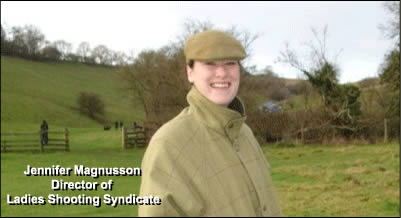
A venue for traditional wingshooting will soon open, tailored specifically for women – and it’s about time.
Called the Ladies Shooting Syndicate, it’s the brainchild of Blixt & Co. in Jackson Hole, Wyoming. The Ladies Shooting Syndicate is by membership only. It organizes splendid shooting trips to luxurious destinations for like-minded women. In effect, Blixt & Co. has transported the Golden Age of Shooting into the 20th century for women with adventurous sensibilities.
My Afternoon With Olympian George Quigley
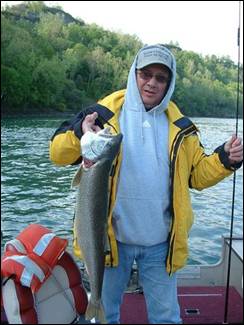
My Afternoon With Olympian George Quigley
Written by Rick Robinson
Author, part-time fisherman and lousy shot
The picture which the folks at Shotgun Life have used to introduce me to you ought to tell you something. All the people profiled in this fine publication are pictured holding their favorite shotguns. My profile picture has me holding up a beautiful lake trout which I caught on the Niagara River cutting the border between New York and Canada.
What that has to do with clay shooting is what my story is all about.
Fishing (or at the least brackish lake water associated with it) is in my family’s blood. My dad had hunted when he was a young man, but by the time I was born he was afflicted with horrible arthritis. So, instead of hunting, he taught me how to shore fish at a young age. On my mom’s side, I had an uncle for which fishing was his life. Just to be able to fish on a daily basis, he spent his twilight living with a Seminole Indian tribe in the Everglades.
So, fishing is one of my sports of preference. Although, the way I fish, calling it a sport is an insult to sportsmen everywhere. I spend more time choosing my cigar for the day than I do choosing my lures. Quite honestly, it’s the quiet and solitude which I enjoy about fishing. Catching a fish is a side benefit.
One of my regular fishing companions, Lytle Thomas, mistook my love of fishing for being an all inclusive outdoor sportsman. Lytle spends his weekends hunting things with and without a pulse.
“I’m running a charity sporting clays shoot next week at Elk Creek,” Lytle said excitedly to me one day. “I signed you up to shoot in my fivesome.”
“I haven’t shot since elementary school,” I replied, hoping that would end the conversation.
“Yeah, I know,” he persisted. “You told me about it. Remember? You won a shotgun for breaking clay pigeons. It’s like riding a bike. You’ll be fine.”
Lytle was only half right. My bragging was catching up with me. My dad had taken me to a youth shooter’s safety clinic when I was a kid. After a lecture from a local 4-H volunteer on safety (don’t ever point a gun at anyone except your calculus teacher), everyone got a turn at the range. Clays were going to be thrown out for us to shoot. The prize for the most clays hit, winner take all, was the shotgun we were using. I missed the first one and then hit all that were served up. My dad was proud (although I do remember overhearing him explain to my mom that I had my eyes closed on each shot).
Dad had visions of some kid in my class with buckshot marks on his face from me trying to shoot rats along the river banks and convinced me to trade the shot gun to a neighbor for a baseball bat and glove or something. Dad was a smart man.
“Anyway, it’s a celebrity shoot,” Lytle snapped me back to reality. “Our celebrity is George Quigley.”
I gulped. I knew just enough about clays to understand that George Quigley was an Olympic shooter. But the thought of spending an afternoon with any athlete who is the best in his sport intrigued me. I accepted the invitation.
“Great,” Lytle exclaimed and told me the real reason for the invite. “My boss is also in our group and he sucks. I put you on my team so that he’ll have someone to beat.”
George Quigley is a legend around my community. He is one of the best known ambassadors of shooting in the world. He and his dad are both nationally ranked. George, Jr. was on the United States Olympic Skeet team which finished 6th in the 1996 Games in Atlanta. He won a gold medal at the 1994 World championships in Cairo.
On the day of the celebrity sporting clays event, I showed up at Elk Creek Hunt Club in Owen County, Kentucky – the home of this year’s US Open. Lytle had loaned me a 12 gauge Beretta 682 Gold E to use for the day. In the parking lot he told me that it was bored and ported to reduce recoil and declared that I was going to use 1 ounce loads of number 8 shot rather than the standard 1 and 1/8th ounce loads.
I pursed my lips and nodded a knowledgeable nod. I had no earthly idea what he was talking about. I took the gun anyway.
After a quick refresher on gun safety in the pro shop where we watched a Dick Cheney speech, I headed to the course.
I looked for Quigley, but didn’t have to really search the crowd. At 6’5″ and around 250 lbs. he stood out. And, he was the only guy at the practice range who was actually shooting. Everyone else was just standing around watching him. “Pull,” he’d shout and two clays would fly out. He’d shoot twice and both clays would explode. “Dead Pair,” he’d say as the crowd applauded.
I decided to wait to introduce myself.
I showed up at our first station. All the men in my group (including Lytle’s boss) were dressed in gear appropriate for a shooting event – ammo vest, shirts with padded shoulders, and orange hats. Suddenly my ensemble of a Bass Pro Shop baseball cap and “Fishermen do it With a Lure” tee-shirt didn’t seem like such a good choice. These guys were serious.
I retreated to what I normally do when I’m intimidated – I became a smartass.
“This clay pigeon thing sounds like fun,” I said approaching the Olympian Quigley with my hand extended. “I hear they are good eatin’ when grilled.”
Lytle shot me a WTF look.
Quigley just stared at me. “Oh God, he’s pissed,” I though to myself. “I’ve just insulted the king and his own sport. This is not a good start to the day.”
Then, Quigley smiled a rather sly grin. “They’re a lot more tender if you boil them first.”
He was as nice of a guy as everyone had said.
I stepped onto the shooting platform, took my first two shots and missed both targets.
Quigley stood behind me shaking his head. He gave a quick beginners lesson on how to balance my feet and gave me a better way to position my shotgun on my shoulder.
“And your eyes,” he said.
“Yeah?” I responded.
“Try opening them.”
What the hell? It had worked the last time.
As I proceeded to each successive station, my shots inched closer and closer to a target. Although I have to admit, I didn’t particularly care if I ever hit a clay. Learning to shoot was one thing. Learning to shoot under the tutelage of George Quigley was quite another. I was watching one of the best and from a very close range.
What was remarkable about George Quigley was the zen-like manner in which he zeroed in on his intended targets. I make jokes about me shooting with my eyes closed, but George’s approach to shooting was just that. He didn’t shoot with his eyes. He shot with feeling. He and the gun were one unit. He didn’t need his eyes. He shot by pure instinct.
George Quigley hit 99 clays out of 100 on that hot summer day. His only miss was a clay that was thrown from behind him. I swear that the shot went past my head as a warning that I better start trying harder. George said it didn’t come anywhere near me. Just to make sure, I started paying closer attention (and standing closer to Lytle).
I feared that George had visions that the president of the National Sporting Clays Association was waiting for him in the pro shop. Being an ambassador of the sport is one thing. But encouraging someone like me to enter the sport was enough for the Association to ban him from competition.
Whether a result of George’s stellar lessons or pure dumb luck, with a few stations left, I suddenly got the hang of it. He was right; you don’t shoot with your eyes. It’s all feel. Each time I hit a clay, Quigley would boldly declare “Dead Pair.”
Suddenly with one station left, I found myself tied with Lytle’s boss. I had the distinct possibility of not being the worst shooter in the match. Lytle glared at me. His whole point of inviting me was to lose to his boss. Quigley, knowing why I had been invited, winked at me. I went 5 for 5.
Dead Pair!
Rick Robinson is an attorney with the law firm of Graydon Head & Ritchey, LLP in Northern Kentucky and the author of political thrillers. His debut title, The Maximum Contribution, was named a Finalist for the Next Generation Indie Book of the Year for political fiction and earned an Honorable Mention at the Hollywood Book Festival. The sequel, Sniper Bid, was released on Election Day and opened on Amazon’s top seller list of political thrillers at #46. He is published by Publisher Page, an imprint of Headline Books. He can be reached via e-mail at: richardleerobinson@yahoo.com.

Visit Amazon.com for Rick’s novel, The Maximum Contribution.

Visit Amazon.com for Rick’s novel, Sniper Bid.
SHOTGUNS and SHE-NANIGANS
A WOMAN’S APPROACH TO SHOOTING FOR FUN AND FRIENDSHIP
Written by Elizabeth Lanier
Getting Started
PULL – What can I say? It is my favorite four-letter word. Why, you might ask? Well, it’s the word used to release a clay target, but what it really turns loose is more fun than you can possibly imagine.
From the moment I step into a shooting box and put two shells in my gun, I cannot help but feel a huge surge of adrenaline and anticipation. As I close the shotgun and prepare to say “that word”, I have to smile and be thankful for the serendipitous journey that has led me to love saying “PULL,” and beyond.
Several years ago I gave my husband a gift certificate for shooting lessons. He was already a rifle shooter, and occasionally an upland bird hunter, so I thought a lesson aimed at the clay target disciplines would be a fun gift for him. I went along the day he was supposed to take the first lesson, ended up shooting with him, and I loved it.
Between carpooling three children around, after school activities and keeping up with home and family obligations, I managed to squeeze in (and steal) his remaining shooting lessons.
Somewhere between the love of pulling the trigger, the desire to succeed, and introducing new shooters to this sport, I realized that it was the “why” of the misses and not the “where” that really mattered.
It was the realization of the importance of good first experiences that compelled me to become an instructor. To know that when I was guiding them through their first attempts with a shotgun, that I was setting them up for success.
When I was initially approached about discussing women’s shotgunning and the pros and cons we face, I was not sure if I could bring any new and novel approaches to shooting. The more I thought back on my own progression in this sport, both as a shooter and now as an NSCA Certified Shooting Instructor of men, women and children, I realized what I could do was be a voice of advocacy and assurance for recreational women shooters through my own experiences.
I stress recreational. The women shooters who are proficient competition shooters already know the fun and fulfillment of shooting. They know the skills and intense mental focus required to compete. No doubt it was the pure pleasure of starting as recreational shooters that compelled them to hone those skills.
I believe there are many, many women who, given the proper introduction to the shotgun sports, would not only love this sport, but excel in it as well. So I say if you have thought about it, why not give it a try?
I know, I know…..what do women think of when they hear someone say “shotguns” or “shooting”? They think of a man’s sport, heavy guns, loud noises, camouflage clothing and killing Bambi or Donald Duck. It does not have to be any of that.
As a female shooter I think of the fun and excitement I experience every time I pull the trigger. I feel a great sense of accomplishment when I hear the bang and see a clay break.
For women who have family members wanting them to shoot or women who just want to try it, I encourage you to seek out a qualified instructor who will guide you through the learning process, paying careful attention to your eye dominance, good form and proper gun placement in the shoulder. They will know the right gauge gun and the best shell to use for the first lessons.
Many well intended people have introduced women and children to shooting with a favorite old hunting gun and perhaps some left over shells from a duck or goose hunt. “It’s easy, just point and shoot”. Trust me, this is not the best way to get started.
If you have started shooting and are looking for fellow shooters, don’t be afraid to go to a nearby shooting range. I have met many wonderful people in the shooting world at nearby gun clubs.
I met another female shooter, now a friend, at a pheasant shoot. After a brief conversation about finding other women to shoot with occasionally, we exchanged numbers on the only paper we had, shot gun shell box tops, and agreed to meet and shoot. I told her it would be fun to try and get other women shooters to join us and try to shoot on a regular basis. We both knew of a few women who shot with their husbands or kids, or had maybe hunted with their father or grandfather in their lives, so we called them to join us. Before you knew it, we had a women’s shooting group.
We now have about 25 members. We have housewives, garden club members, doctors, lawyers, artists, as well as a pilot and teacher. It is a fun loving, diverse group of women who have gone from shooting once a month to occasional 2 day excursions planned around shooting courses, shopping and all the shenanigans that go along with it all……fun shooting, good gear and great dinners, all topped off with a whole lot of laughs. Every now and then we even let our husbands join us.
Like I said, why not give it a whole hearted try? Whether a beginner or more experienced shooter, there is always merit in good instruction and learning to shoot better and better by building your shooting inventory….to me that includes getting the gear but we will talk about that later.
Women communicate. They will convey their feelings if they are anxious or excited. They are gatherers. They like to understand and replicate instructions and often learn much more by visual demonstrations that just an explanation.
Stay with Shotgun Life….soon we will talk about how we gather information, process it and incorporate it into building that shooting inventory we are talking about. We will also discuss trying to find good “girl” gear, starting women’s shooting groups, shooting and shopping adventures and more. Whew….so much to cover, so little space……….stay tuned.
Elizabeth Lanier is an NSCA Level I instructor based in Virginia. Please send your questions to elanier@shotgunlife.com. Every week, she will update her monthly column by selecting one question and post both the question and answer to her column so that all her readers can benefit.
Question for March 2009:
Hi, Ms. Lanier,
I just recently read your article and like the way you think! Look forward to reading your future articles. I haven’t been shooting very long and would like to know what your opinion is on which choke I should use in Sporting Clays for an over-under gun? I shoot just for fun and camaraderie.
Thank you,
Debbie
Elizabeth’s Answer:
Dear Debbie,
Thanks for your interest and I’m glad to hear you have taken up shooting.
In response to your question about chokes, I will just briefly tell you how they work first. A shotgun choke is a constriction at the end of the barrel of the gun. It tightens the shot string of the pellets just before they leave the barrel. I had an instructor give the analogy that the choke worked much like the nozzle on the end of a garden hose. The more open it is, the more open the spray is as it leaves the hose; and the tighter it is, the further the stream goes before opening up.
The most open choke is a cylinder. Then you have skeet, improved cylinder, modified, improved modified and full chokes. And, to confuse you more, there are choke tubes sizes between many of those.
You stated you are a beginning shooter so I would suggest using skeet chokes in both barrels to begin with, or a skeet choke in the bottom barrel and an improved cylinder in the top as you improve. These chokes work well with light loads such as 7/8 oz. to 1 oz. with number 8 shot.
Judy Rhodes Gets Women Out of the Mall and into the Hunt
There was a golden time in America when fresh-faced kids could routinely bring their guns to school, stash them in their locker with books and lunch boxes, and then after football practice all run out to a big field and shoot at rusty cans and elusive squirrels with their very own .22.
As a girl growing up on a ranch in Texas, those days are still a living memory for Judy Rhodes – and it’s her mission in this God-given life to share that boundless joy with other women today.
Judy has been toting a gun since the age of four and she got her start hunting rats, pigeons “anything that was a nuisance” using her first Red Ryder BB gun. At 8, she got her first real gun, which was a .410 shotgun.
Judy recalls that during those days she was “a ringleader of organizing people to go out and shoot. Maybe 30 kids would go after a game… only two girls, and the rest were guys…it was a time when girls weren’t encouraged to play sports.”
But being a rancher’s daughter, Judy said she didn’t know there were any limitations for girls. “I was used to the call of the wild.”
Little did Judy know at the time that those wonder years of her life would set the foundation for her to become one of the leading advocates for introducing women to the shooting sports and that very same call of the wild.
When she left home to attend Oklahoma University, her natural talents as a hunter and leader roped in some “Yankees” from the East Coast, where she demonstrated her early talent to get people involved in the kind of life that Judy loved.
She recalled how she had invited those East Coast guys back to her home in Texas. “It was my first time around Yankees who had never been exposed to the outdoors,” she says, laughing.
Judy remembered how she would get them on a horse and to touch a cow – often the first time her new friends got that close to livestock – or any big animal. Then, at night, Judy introduced them to hunting as they stalked coyotes.
After college, Judy returned to Texas where she landed a job as an interior decorator working on high-profile projects such as the Ritz Carlton in Dallas. Back home now, she got right back into hunting, which turned out to bring her some business because there simply weren’t that many women at the time who shared her passion for the sport.
One day, she was on the job and “a cowboy gets in the elevator. He’d just come back from hunting in Wyoming.” What neither of them realized was that they both worked for the same company. In fact, as the vice president of finance, he signed her checks.
The stars were aligned, and they got married. For their honeymoon, they went hunting in Wyoming.
In 1999, Judy was recruited to the board of the Women’s Shooting Sports Foundation — an arm of the National Shooting Sports Foundation. The charter of the WSSF was to get women more involved in the shooting sports and hunting, as well as function as sort of a lobbying group to influence manufacturers and retailers on the special needs of women shooters (and Judy has some strong opinions about that).
When the WSSF ultimately dissolved, she started the Texas Divas, which is short for Texas Women’s Shooting Sports/DIVAS. It is now known as Women Outdoors Worldwide – Divas WOW – and remarkably is celebrating its tenth anniversary this year.
Today, DIVAS has members in 49 states and 15 foreign countries. Over the years, DIVAS has taught over 800 women how to shoot a shotgun. They don’t call them chapters, they’re called liaisons because it’s a sisterhood – women who need encouragement to enjoy the outdoors.
Her motto is “Women Helping Women…Women Teaching Women…Women Supporting Women.” Her leadership in shooting, hunting and civic organizations led to a major story with photograph (including shotgun) in the Today Section of USA Today in March 2006.
She has also been featured in stories promoting women’s positive outdoor experiences throughout the world, including broadcasts on German Television and the United Kingdom BBC Television.
Maybe that’s where she got the TV bug. She started Divas in the Outdoors Television Show for reaching women and families worldwide. The show taught simple techniques from professionals. Divas in the Outdoors was the number-two show on MOR (Men’s Outdoors and Recreational) shown on Direct TV, DishNetwork, Comcast and Turner Media.
All the while, Judy has been to South Africa 18 times, in addition to Spain, Argentina, Scotland, England, Canada and Mexico, as well as all over the U.S.A.
Her leadership, enthusiasm and commitment have made Judy the voice of outdoor women within the industry. As you can appreciate, she has a word or two for shotgun makers.
“Make guns that fit us.”
Judy believes that the Beretta 391 semi-automatic is probably the best-fitting full-size gun for women on the market. Otherwise, she recommends that smaller framed women get themselves a youth gun.
But knowing Judy, we can expect to see a lot more shotguns on the market tailored to women.
“When we conduct our clinics women are afraid and we tell them that women can’t be afraid. They know what guns can do, but don’t know how to use them. But once a woman hit her first target its amazing how they want to go out and be a marksman and buy their own guns,” she observed.
There was something else Judy discovered about women involved in the shotgun sports.
“Women enjoy the smell of gunpowder.” She went as far as to say that women considered the smell of gunpowder a turn on.
Does that mean there’s a new women’s fragrance in Judy’s future? Not really, but she is exploring the possibility of returning to TV this September.
“It will involve a lot of women and the outdoors,” she said.
Judy honestly feels that she has been chosen by a higher power to get women involved in hunting, shooting and the great outdoors. “It’s a sisterhood, a bonding, to make sure we have that next generation of women shooters. This is a mission I believe that I have in life.”
Irwin Greenstein is Publisher of Shotgun Life. Please send your comments to letters@shotgunlife.com.
Helpful resources:
You do what… ?
She’s a teacher, an artist, and a ballet aficionado originally from Brooklyn, New York–and an avid clay shooter!
If this doesn’t entirely add up, don’t be surprised. Sometimes, even Bonnie Berniger herself wonders how she ended up becoming passionate about clays shooting.
“My friends can’t understand how I can go from the arts to shooting,” she says. “People from Brooklyn don’t understand that shooting could be a sport. They associate a gun with crime. When I come into work happy after a weekend of shooting, they looked at me very strangely.”
Shooting Sporting Clays With The Ghost of Johnny Reb
The opportunity to shoot sporting clays on hallow ground doesn’t present itself that often, but you can do it in the area of Manassas, Virginia where the battles of Bull Run were fought.
Depending on which side of the Mason-Dixon Line you’re standing, it’s called either the First and Second Battle of Bull Run (as it’s known in the North) or the First Battle and Second Battle of Manassas (the Southern name for it). The first battle took placed July 21, 1861 while the second, larger battle was fought August 28-30, 1862.
Shotgun Life Newsletters
Join an elite group of readers who receive their FREE e-letter every week from Shotgun Life. These readers gain a competitive advantage from the valuable advice delivered directly to their inbox. You'll discover ways to improve your shooting, learn about the best new products and how to easily maintain your shotgun so it's always reliable. If you strive to be a better shooter, then our FREE e-letters are for you.
About Shotgun Life
Shotgun Life is the first online magazine devoted to the great people who participate in the shotgun sports.
Our goal is to provide you with the best coverage in wing and clays shooting. That includes places to shoot, ways to improve your shooting and the latest new products. Everything you need to know about the shotgun sports is a mouse-click away.
Contact
Irwin Greenstein
Publisher
Shotgun Life
PO Box 6423
Thomasville, GA 31758
Phone: 229-236-1632

